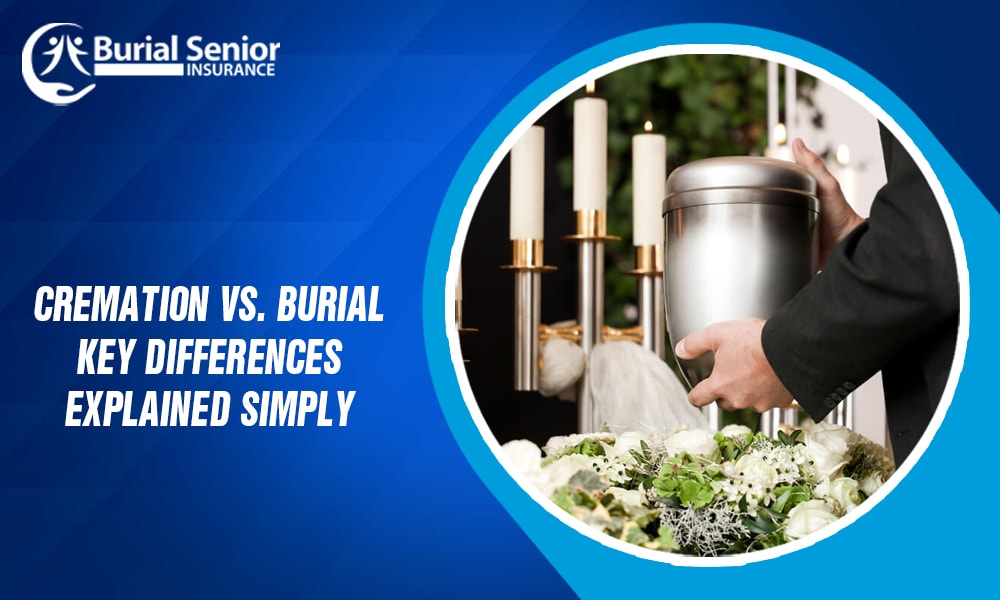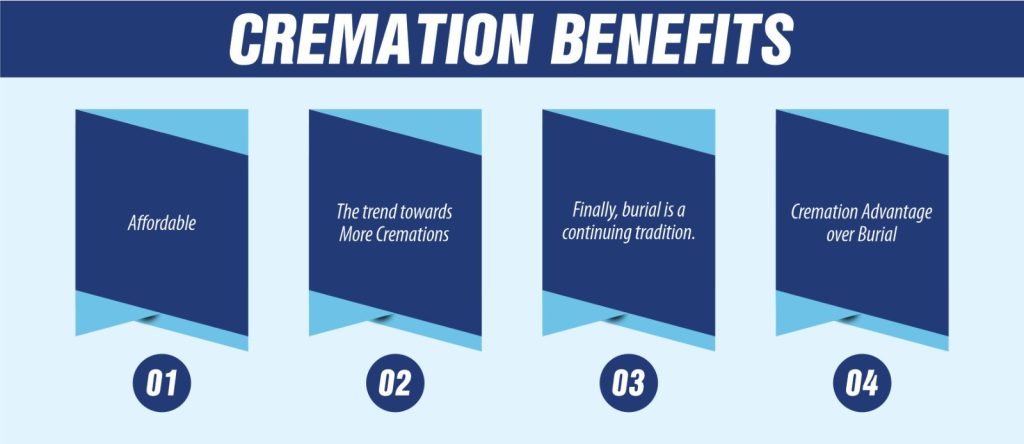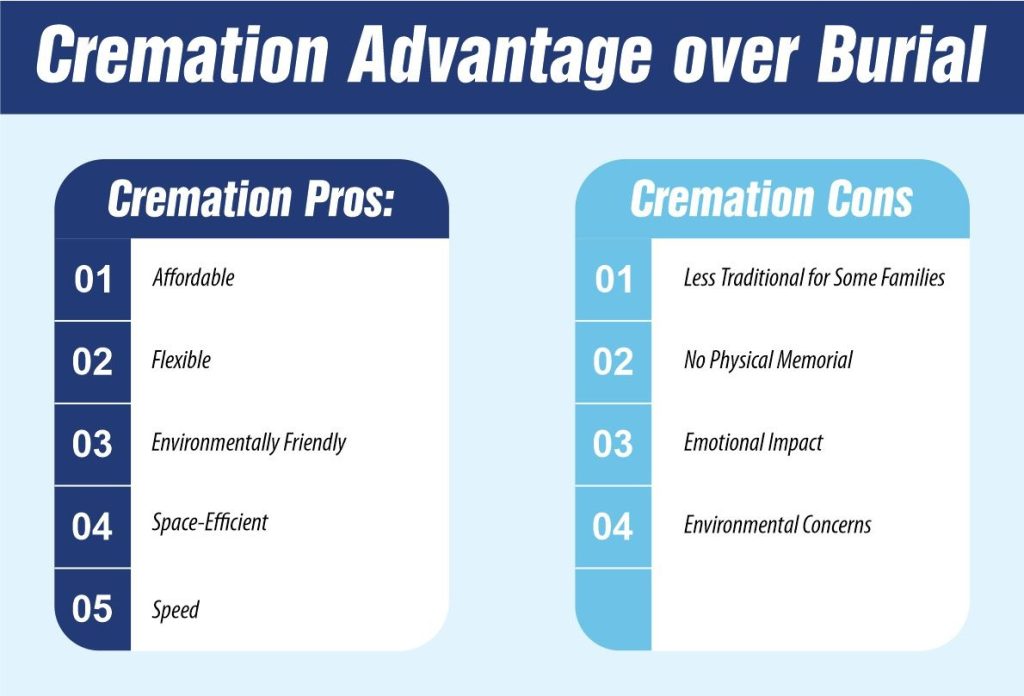Last Updated on: March 10, 2025
Reviewed by Kyle Wilson

Hearing the terms Cremation vs. Burial, there are certain aspects to which people tend to pay attention including cost, religion, ecology, and preference. Knowledge of the differences will help one make the right decision, in a situation one is required to make a choice between the two options.
Get Free Quotes
Customized Options Await
Therefore, before choosing the type of funeral to undertake, it is important to consider the budget implications of cremation and burial. These costs are different and those who hope to start a family should be aware of what they are to make the right decision.
Cremation cost is usually low as compared to burial. The common cost includes the cremation procedure, the urn, and other services provided, wherein many families can personalize the kind of memorial service to match their financial status. In such states as California, cremation is expensive due to the high cost of land for burial. Likewise in Texas, cremation is fast becoming an acceptable method of burial in as much as it is cheap and flexible.
It is also relatively cheaper than burial since it has various costs including embalming, a casket, a burial plot, and a headstone. Other burial costs may include the fees for opening and closing the grave or the costs of maintaining the cemetery’s property. These extra costs make burial a more profound financial investment, especially when the location of this investment is either scarce or pricey, as is usually the case with urban graveyards.
Cremation reduces many impersonal costs which can be buried deep in setting up a burial plot or paying cemetery costs. Others can even prove costly by settling for cheaper or simpler forms of honoring their deceased loved one or lack the need to place a body to rest.
People often encounter hidden expenses when being buried, including the cost of the cemetery’s long-term care of the plot and the possible expense of the burial vault. Such costs continue to accrue thereby putting additional costs on families and may at one point overwhelm them.
As the decision on which of these processes of laying the deceased is best, many Christians seek the word of God. Although these choices depend on cultural practices and individual tastes, religious scriptures and the contemporary interplay of culture give direction as to the reasons for such choices.
Specifically, scripture does not speak to cremation or burial and while one might infer scripture speaks against cremation, that interpretation is up for debate. But was focused at deeper levels on propositions about life, death, and the resurrection that are more tangible. This lack of a direct command has let Christians come up with many points of view based on biblical motifs and traditions.
According to Genesis 3:19, some Christians believe that cremation is consistent with the biblical idea of returning to dust. Thus, repeating it to the man who was lying there, “Dust you are, and to dust you will return.” These are the meanings that cremation holds; Duhkha; the rib; the flame; decay; ashes; fire; and impermanency of the physical body among others. Even though cremation was not typical in biblical days, they tried to find some way to do cremation to remember the fact that earthly life is short and temporary but at the same time the body of a believer should be honored.
A living burial means that the departed has been traditionally buried to be honored as if it is done today and in biblical times. God had his favorites buried among other scriptural giants like Abraham and Sarah, Jesus was also buried, and based on the teaching of the scriptures, Christians prefer burial as the best method of burying their beloved ones. Burial is often seen as a symbol of respect and hope in the resurrection, as the body is placed in the ground in anticipation of being raised again, echoing verses like 1 Corinthians 15:have been published regarding the doctrine of the resurrection of the body at 42-44.
While in the early Church, the focus is made on how the body of the deceased should be treated, modern Christianity aims primarily at presenting resurrection and life everlasting. Today many Christians consider the nature of body disposal – cremation or burial – as inconsequential to spirituality or the completion of resurrection.
An evaluation of cremation in the United States today points to cultural and practical issues concerning burial and traditions of Christians, referring not just to today but also to the past few decades. Courtesy of cost components, environmental concerns, and scarcity of burial space, cremation has become a more popular option. To most people, cremation is purely a practical process and not theological at all, told that god can raise people from ashes.
However, the trend of cremation daily practiced burial is still regarded as significant in the Christian culture. The reason for choosing it is that it symbolically refers to biblical procedures and focuses on the protection of its dignity. The burials, help to sustain the visible signs of hope in the resurrection of Christ; and again, touch the actual side of life, helping to console the remaining families through the possibly comforting and actual links to the biblical tradition.
When weighing this out between cremation and burial, some factors that should help in making the decision include; Cremation as well as burial are both good methods of doing away with the deceased, but they have their advantages in regards to their efficiency, religion, and conservancy. This understanding can therefore assist the various families to make the right and most appropriate decision.

While in the early Church, the focus is made on how the body of the deceased should be treated, modern Christianity aims primarily at presenting resurrection and life everlasting. Today many Christians consider the nature of body disposal – cremation or burial – as inconsequential to spirituality or the completion of resurrection.
An evaluation of cremation in the United States today points to cultural and practical issues concerning burial and traditions of Christians, referring not just to today but also to the past few decades. Courtesy of cost components, environmental concerns, and scarcity of burial space, cremation has become a more popular option. To most people, cremation is purely a practical process and not theological at all, told that god can raise people from ashes.
However, the trend of cremation as a daily practiced burial is still regarded as significant in the Christian culture. The reason for choosing it is that it symbolically refers to biblical procedures and focuses on the protection of its dignity. Regard to the burials help to sustain the visible signs of hope in the resurrection of Christ; and again, to touch the actual side of life, helping to console the remaining families through the possibly comforting and actual links to the biblical tradition.
When weighing this out between cremation and burial, some factors that should help in making the decision include; Cremation as well as burial are both good methods of doing away with the deceased, but they have their advantages in regards to their efficiency, religion, and conservancy. This understanding can therefore assist the various families to make the right and most appropriate decision.
Cremation and burial are changing as a result of the society, economy, and ecology’s transformation. It helps to know how they change over time and how that correlates to region or age group so that a company can better tailor their products.
In the United States of America, cremation is at the request of more families than burial hence taking the central stage about the funeral rites. This can be predominantly linked to the lower cost of cremation, as well as the increased relevance to new generation values of such forms of burial. Industry research indicates that more than fifty percent of Americans opt for cremation services, and the ratio is likely to grow in the future.
To some extent, the cost aspect is a consideration – cremations are cheaper than burials that entail buying caskets, land, and the annual upkeep on the burial grounds. Also, cremation is versatile because it allows families to choose favorite memorial ideas, making ashes burial in special places or an urn at home.
Cremation is more common in urban areas as burials are not only becoming scarce but also expensive due to the ever-limited space locally. Lack of adequate land space in urban areas has put pressure on cemetery space and costs, hence making burial prohibitive for most people. Other factors that have led to the modern demands for cremation include environmentalism the desire to avoid the use of embalming chemicals, and the lack of space for burial for large populations living in metropolitan areas.
Concerning the sending-end regions, there is a strong preference for traditional burial, characteristic of rural cultures and religious beliefs that regard inhumation as the preferred method of interment. Most of the rural areas enjoy adequate land space for burials, and indeed the costs are far cheaper as compared to those of their urban counterparts. As depths of burial from religious traditions are highly regarded in these areas, their standards still dominate. There are families in rural areas that consider burial as a useful method that enables them to follow cultural practices when the deceased person dies as well as offering the family an opportunity to visit the deceased person and see where they are buried.
The share of cremations about burials increases year by year across the territory of the country. Experts estimate that the cremation rate will cross 75% in some states over the next ten years due to the economical and eco-friendly approach. Causes include; mobility, changing family structures, and deviation from traditional burial practices.

The choice between cremation and burial is one the families go through based on factors such as practicality, emotions, and culture. In making this decision one must consider the following factors to choose that which is most suitable for a family. Here are some elements to guide your decision-making process:
An important reason when it comes to cremations or burials is usually the financial aspect. Cremation costs less most of the time due to other charges like embalming, caskets, and burial places not being included. However, burial may still be the preferred option for those who so much embrace tradition and those willing to dig deep into their pockets. The price estimates should however be conducted based on the location and even carriers and centers that are available where you come from and where you are going since prices may slightly vary.
Your belief system – religious, cultural, and otherwise – is once again decisively involved with this process. Some religions prefer burial because they believe that it is the right way to pay respect to the human body and it is traditional. Some people are also embracing cremation, as time changes, looking towards the soul, not the body as earlier Eg., the changes in attitude towards it among the whites today. Sometimes it can make things easier to think about what is most fitting with what you consider right and wrong.
This is an issue of concern given the environmental consequences of cremation as well as burial. Most people consider cremation to be more environmentally friendly than burial due to the lack of chemicals used for preservation and the land required for burial. But cremation also involves the consumption of energy and pollutants emission into the atmosphere. That would be the other category of alternative burials called natural or green burials which many people may consider as an environmentally friendly option to both burials and cremation because they do not use formalin.
It is useful to announce your preferences to the members of the family because this way everyone feels free to express dislike towards any type of music. Several of the deceased’s closest may feel as natural or important to preserve traditions, to create a place in memory, or to disperse the ashes in a certain manner. The lack of communication hinders everyone as accepted decisions can be made through consensus and everyone rationalizes that no one is happy about the situation and it suddenly gives a sense of togetherness.
This is what you should consider when deciding whether to bury or cremate: the ways that you want to be remembered. A few people may prefer the idea that there is a burial site that can be more or less frequently visited by close ones and see a cognizable gravestone. Some people may view cremation as more convenient because the ways that people’s memory is honored can be more easily changed.
Another perspective is the consideration of the effects that the decisions and actions taken today have on the following generations. If your family wanted to have a place to visit and be reminded of you, then a burial may be nice. On the other hand, the cremation might allow the family members to have a better chance of deciding how to remember you and also through keepsakes, ashes at home, ashes at a location of your choosing, or a special location.
Some of the religions have clear stands regarding burial or cremation. For instance Baptists, the Christian Church, the Orthodox Church, and other Roman Catholics have for years supported burial on grounds that, burials show respect for dead bodies, and in Christianity’s teaching dead people will be resurrected later. Most other religions like Hinduism prefer cremation for example based on the notion of the soul’s journey. Using the teachings of our religion or spirituality will assist in coming up with a decision with such principles in mind.
Cremation and burial are known to be very sensitive to be determined by the costs, culture and religion, and lastly family values. Cremation is a more suitable and cost-effective solution than burial, while burial is a more conventional method of handling the deceased. Sometimes, it boils down to what you value in life and what will give your loved ones peace regardless of the choice you make.
Burial, on the other hand, is slightly more costly than cremation. Cremation expenses usually include the process, an urn, and a funeral if desired, while burial involves the use of a funeral home, burial preparation, a casket, and a plot.
Although cremation is not discouraged in the bible, neither is it banned. A lot of people assume it aligns with the Christian teaching of returning to dust and concentrating on the aspect of rising from the dead rather than how the body is dealt with.
Cremation seems to be less invasive in terms of the environment as it uses no space, and most funeral services avoid the use of chemicals for embalming the dead. These aspects make burial have a larger environmental impact Therefore, extending the options open to the deceased beyond traditional burial practices.
Cremation seems to be on the rise and has overshadowed burial since the last decade because of the cost and space availability.
In most places, the scattering of ashes is permitted, but the degree to which is regulated depends on the area. Compared with overseas situations, people also need to pay attention to the local legal systems and make sure to get all the approvals if needed.
Senior Writer & Licensed Life Insurance Agent
Iqra is a dynamic and insightful senior writer with a passion for life insurance and financial planning. With over 8 years of hands-on experience in the insurance industry, Iqra has earned a reputation for delivering clear, actionable advice that empowers individuals to make informed decisions about their financial future. At Burial Senior Insurance, she not only excels as a licensed insurance agent but also as a trusted guide who has successfully advised over +1500 clients, helping them navigate the often complex world of life insurance and annuities. Her articles have been featured in top-tier financial publications, making her a respected voice in the industry.

Burial Senior Insurance provides information and services related to burial insurance for senior citizens, including policy options and end-of-life support services.
Copyright © Burial Senior Insurance 2025. All Right Reserved.

Get Free Life Insurance Quotes